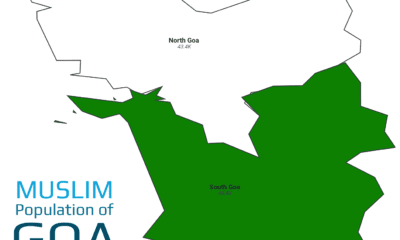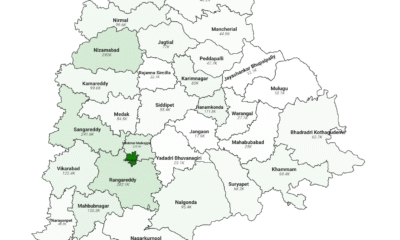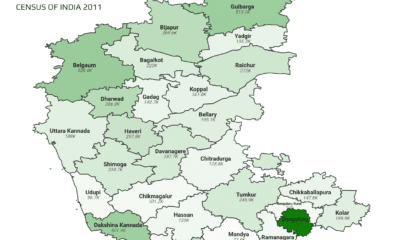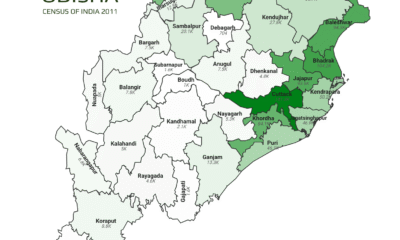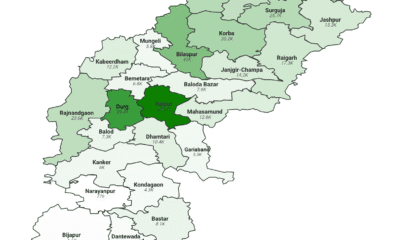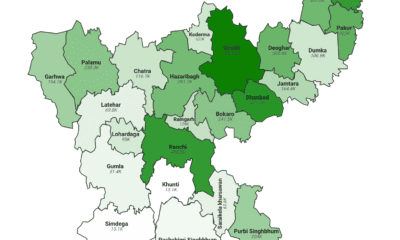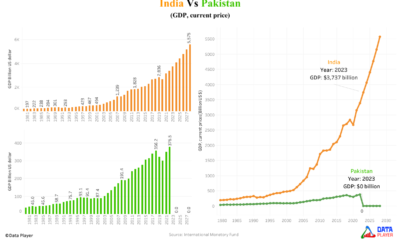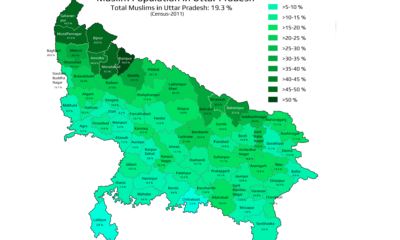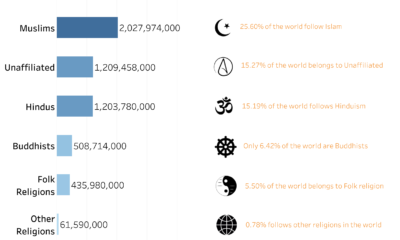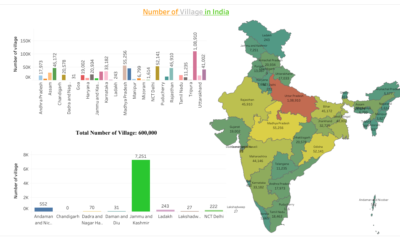Published
5 months agoon
Tamil Nadu, a culturally rich state in southern India, is home to a diverse Muslim population of around 4.2 million, making up 5.86% of the total population, according to the 2011 Census of India. The community is spread across the state, with notable concentrations in districts like Ramanathapuram (16.7%), Tirupathur (11.5%), Vellore (9.2%), and Chennai (7.6%).
Most Muslims in Tamil Nadu follow Sunni Islam, with strong traditions of Sufi practice and shrines (dargahs) playing a visible cultural role. Tamil is the main language, and the community actively participates in local traditions and festivals.
Economically, Muslims in Tamil Nadu are involved in leather work (notably in Vaniyambadi and Ambur), textiles, wholesale markets, and small-scale industries. Educational institutions, tailoring units, and eateries are commonly run by the community, especially in urban centers like Chennai and Madurai.
Chennai has the highest Muslim population in Tamil Nadu, with 439,270 Muslims, reflecting its urban density and historical trade connections. Coimbatore follows with 211,035, while Ramanathapuram ranks third at 208,038, notable for its significant community despite a smaller total population. Other top districts include Tiruchirappalli (190,964), Thanjavur (190,814), and Tirupattur (170,360). Madurai, Tirunelveli, Vellore, and Thiruvallur also feature prominently, each with over 140,000 Muslims. This distribution shows that both urban centers and historical heartlands contribute to the strong presence of Muslims across Tamil Nadu.
Ramanathapuram tops the list with 15.37% of its population being Muslim, reflecting its deep-rooted Islamic heritage and coastal connections. Tirupattur follows closely with 13.91%, while Nilgiris stands at 10.67%, influenced by its historical settlements. Vellore (10.41%), Tenkasi (9.91%), and Tirunelveli (9.82%) also showcase significant Muslim communities. Urban hubs like Chennai (9.45%) and coastal Nagapattinam (8.94%) maintain high percentages, supported by trade and migration. Thanjavur (7.93%) and Thiruvarur (7.6%) round out the top ten, reflecting balanced rural-urban distribution. These figures highlight the rich diversity and integration of Tamil Nadu’s Muslim population across different regions.
At the bottom of the list, Ariyalur has the lowest share of Muslim population in Tamil Nadu with just 1.05%, followed by Namakkal (1.88%) and Virudhunagar (2.46%). Dharmapuri (2.54%), Salem (2.74%), and Erode (3.38%) also show relatively small Muslim communities. Other districts with lower percentages include Kallakkurichi (3.7%), Tiruvannamalai (3.72%), Chengalpattu (3.84%), and Thiruvallur (3.84%). These regions typically have a more dominant Hindu demographic and fewer historical Muslim settlements. Despite their lower numbers, Muslim communities in these districts continue to contribute actively to local economies and cultural life.
1. Chennai: India’s southern metropolis houses 439,270 Muslims, 9.45 % of its 4,646,732 people. Triplicane’s 1795 Big Mosque and the busy Royapettah leather bazaar show a community rooted in trade and education. Rising IT jobs and Gulf remittances should push numbers upward, keeping Chennai the state’s largest urban Muslim hub.
2. Coimbatore: Textile‑rich Coimbatore hosts 211,035 Muslims ( 6.10 % of 3,458,045 ). Many run power‑loom units in Kuniyamuthur and create the famed “Kovai burqa.” With the city courting aerospace and start‑ups, Muslim youth are shifting toward engineering and logistics, suggesting slow but steady population growth.
3. Ramanathapuram: Although its total population is just 1,353,445, Ramanathapuram counts 208,038 Muslims—a state‑high 15.37 %. Coastal trade with Arabia left behind hundreds of stone mosques and Tamil‑Arabic loanwords. Fishing and Gulf migration dominate livelihoods; stable birth rates mean the share should remain the state’s highest.
4. Tiruchirappalli: Historic Trichy records 190,964 Muslims (7.01 % of 2,722,290). The colonial-era Teppakulam mosque district still bustles with beedi, gem, and tailoring units. As the new industrial corridor expands, analysts expect gradual in‑migration from delta towns, keeping Muslim numbers on a gentle climb.
5. Thanjavur: Cauvery delta’s rice bowl has 190,814 Muslims, 7.93 % of 2,405,890 residents. Thanjavur’s bronze artisans include many Muslim families crafting temple icons—an unusual syncretic trade. Agro‑processing jobs may slow out‑migration, so the community should hold its share.
6. Tirupattur: Leather town Tirupattur reports 170,360 Muslims (13.91 % of 1,224,467). Tannery exports drive household incomes. Environmental restrictions are pushing factories toward eco‑friendly methods, likely retaining Muslim workers locally and sustaining a double‑digit share.
7. Madurai: Temple city Madurai hosts 168,881 Muslims (5.56 % of 3,038,252). The Nelpettai spice bazaar is a Muslim stronghold. With the AIIMS‑linked medical hub coming up, health‑sector jobs may nudge the community’s numbers upward.
8. Tirunelveli: Southern Tirunelveli tallies 166,122 Muslims, 9.82 % of 1,692,296 inhabitants. Halwa shops on Jawahar Street are Muslim‑run icons. Planned port connectivity in nearby Enayam could draw youth home, stabilising their proportion.
9. Vellore: Fort city Vellore counts 157,402 Muslims (10.41 % of 1,512,563). Ambur and Vaniyambadi tanneries spur high overseas remittances. As leather shifts to value‑added goods, the Muslim share should edge up.
10. Thiruvallur: Fast‑urbanising Thiruvallur carries 143,093 Muslims—just 3.84 % of 3,728,104. Many work in Chennai’s auto belt. Continuing in‑migration from northern districts may slowly lift their percentage.
11. Tenkasi: Newly carved Tenkasi logs 137,246 Muslims (9.91 % of 1,384,937). Courtallam’s tourism season fuels small Muslim‑owned lodges and eateries. Stable fertility suggests the share will hold near 10 %.
12. Tiruppur: Knitwear capital Tiruppur has 123,983 Muslims, 5.00 % of 2,479,052. They dominate embroidery‑unit labour. Automation may temper growth, but diversification into logistics could keep numbers steady.
13. Cuddalore: Coastal Cuddalore shows 123,749 Muslims (4.75 % of 2,605,914). Cashew‑processing jobs and port redevelopment may attract more families, inching the share upward.
14. Krishnagiri: With 115,303 Muslims (6.13 % of 1,879,809), mango‑rich Krishnagiri exports leather and fruit. The proposed Bengaluru–Chennai highway is expected to boost Muslim trucking businesses, nudging population growth.
15. Pudukkottai: Pudukkottai lists 114,194 Muslims (7.06 % of 1,618,345). Rock‑cut mosques highlight centuries‑old links. Clay‑tile and construction sectors could sustain current numbers.
16. Kancheepuram: Silk city Kancheepuram hosts 110,992 Muslims (4.70 % of 2,362,259). Many weave zari borders for saris—a niche likely to persist, keeping population growth modest.
17. Dindigul: Dindigul registers 105,012 Muslims (4.86 % of 2,159,775). The famed lock‑making Muslim clusters may shift toward e‑commerce, encouraging youth to stay and maintain share.
18. Thiruvarur: Agrarian Thiruvarur tallies 96,092 Muslims, 7.60 % of 1,264,277. Traditional urumee drum makers hail from the community. Mechanised farming may curb out‑migration, so numbers should remain stable.
19. Salem: Industrial Salem notes 95,487 Muslims (2.74 % of 3,482,056). Steel and textiles employ many. Unless migration patterns change, Muslim share will stay modest.
20. Tiruvannamalai: Pilgrimage hub Tiruvannamalai has 91,636 Muslims, 3.72 % of 2,464,875. Many run sweet stalls for temple crowds. Tourism expansion could slightly lift their population.
21. Ranipet: Ranipet records 86,998 Muslims (7.25 % of 1,199,301). New leather clusters and SIPCOT parks signal future job growth, likely sustaining or raising their share.
22. Thoothukkudi: Port city Thoothukkudi counts 80,740 Muslims (4.61 % of 1,750,176). Shipping and salt‑works offer employment. The VOC port expansion may attract more Muslim labour.
23. Kanniyakumari: Southern tip Kanniyakumari features 78,590 Muslims (4.20 % of 1,870,374). Many manage souvenir shops. Coastal erosion mitigation projects could retain fishing families, keeping numbers level.
24. Nilgiris: Hilly Nilgiris holds 78,452 Muslims, a notable 10.67 % of 735,394. Tea‑estate work and tourism sustain the share, expected to stay steady amid eco‑tourism growth.
25. Erode: Erode logs 76,098 Muslims (3.38 % of 2,251,744). Turmeric trade involves Muslim brokers. Unless industrialisation accelerates, population growth will be slow.
26. Sivagangai: Sivagangai shows 74,310 Muslims (5.55 % of 1,339,101). Chettinad architecture includes mosques with tile‑roofed halls. Handicraft revival may keep youth local, maintaining numbers.
27. Viluppuram: Viluppuram hosts 71,142 Muslims (4.03 % of 1,764,615). Highway eateries run by Muslims serve travellers; upcoming rail projects could modestly boost their share.
28. Mayiladuthurai: Mayiladuthurai notes 66,230 Muslims (7.21 % of 918,356). River Cauvery tourism and jasmine trade engage many. Steady birth rates suggest unchanged proportions.
29. Chengalpattu: Chengalpattu lists 62,793 Muslims (3.84 % of 1,635,993). Proximity to Chennai’s IT corridor offers jobs, likely nudging the share slightly upward.
30. Kallakkurichi: Kallakkurichi counts 62,754 Muslims (3.70 % of 1,694,258). Sugarcane markets employ many; mechanisation may slow growth.
31. Nagapattinam: Cyclone‑prone Nagapattinam hosts 62,387 Muslims (8.94 % of 698,094). Fishing and dhow building are core trades. Port modernisation could raise their numbers.
32. Theni: Theni has 56,751 Muslims (4.56 % of 1,245,899). Cardamom and grape farming absorb labour; continued agri‑exports may stabilise the community.
33. Karur: Karur records 53,292 Muslims (5.01 % of 1,064,493). Home‑textile export units employ many women. Global demand hints at steady population retention.
34. Virudhunagar: Virudhunagar logs 47,838 Muslims (2.46 % of 1,942,288). Fireworks and sesame oil trades involve Muslims. Safety regulations could limit industrial jobs, keeping share low.
35. Dharmapuri: Dharmapuri holds 38,304 Muslims, 2.54 % of 1,506,843. Many work in granite quarries. Unless diversification occurs, Muslim population will grow slowly.
36. Perambalur: Small Perambalur counts 32,702 Muslims (5.79 % of 565,223). Maize processing offers seasonal work; agro‑parks may attract new families, inching up share.
37. Namakkal: Namakkal registers 32,483 Muslims (1.88 % of 1,726,601). Poultry logistics dominate jobs. Unless urban pull increases, Muslim growth will stay minimal.
38. Ariyalur: Ariyalur, the state’s least‑represented district, has 7,942 Muslims, only 1.05 % of 754,894. Cement factories attract migrant labour, so a slight uptick is possible but overall share will likely remain the lowest in Tamil Nadu.
Muslim Population of Tamil Nadu by its Districts dataset Census 2011
You may like


Muslim Population in Goa (2025 Update): District-Wise Data, Percentage & Analysis


Muslim Population in Telangana (2025 Update): District-Wise Data, Percentage & Analysis


Muslim Population in Karnataka (2025 Update): District-Wise Data, Percentage & Analysis


Muslim Population in Odisha (2025 Update): District-Wise Data, Percentage & Analysis


Muslim Population in Chhattisgarh (2025 Update): District-Wise Data, Percentage & Analysis


Muslim Population in Jharkhand (2025 Update): District-Wise Data, Percentage & Analysis
Religion
Muslim Population in Goa (2025 Update): District-Wise Data, Percentage & Analysis
Published
4 months agoon
August 10, 2025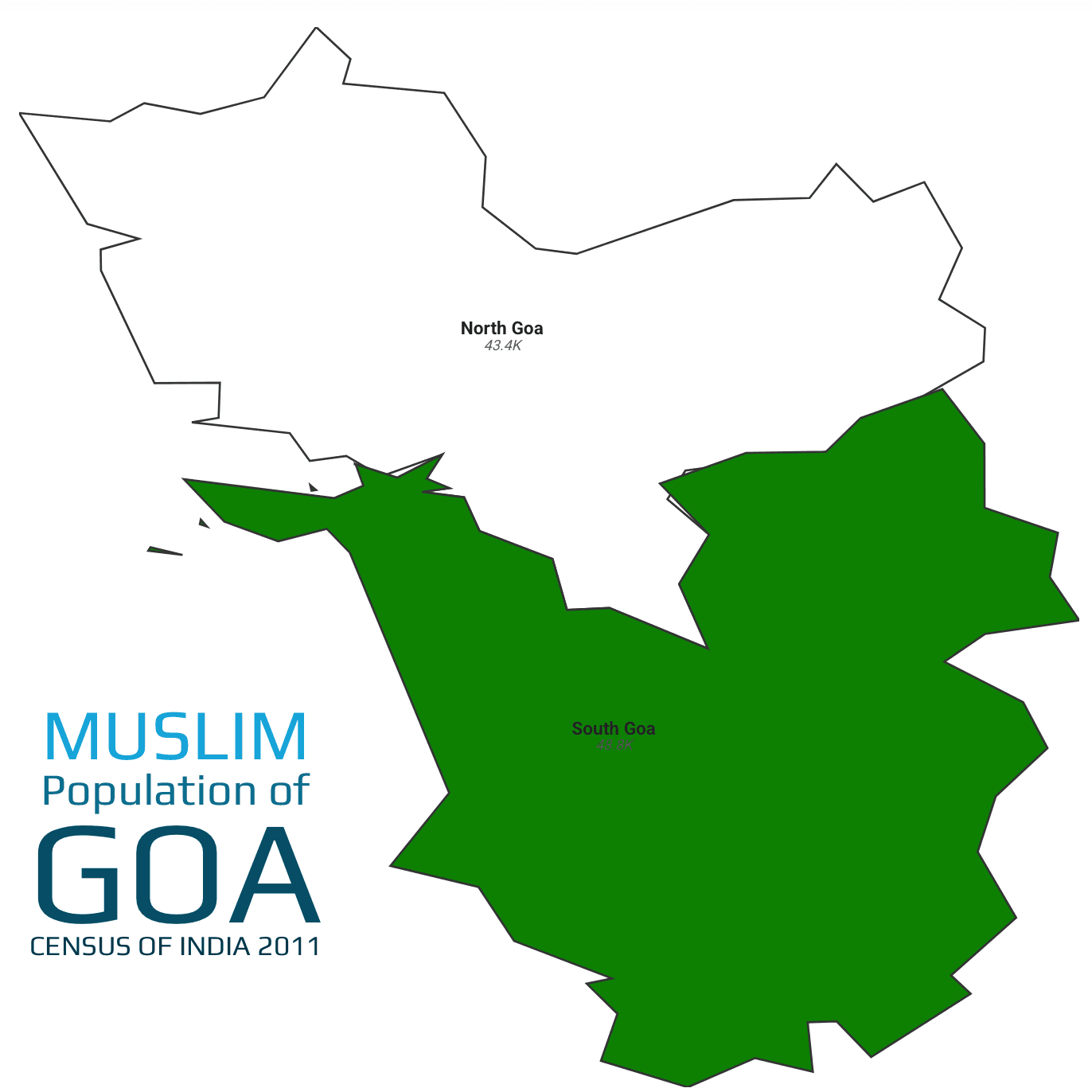
Excerpt: Goa, India’s western coastal gem, is renowned for its beaches, spice plantations, and vibrant tourism-driven economy. Though predominantly Hindu, the state is home to a small but dynamic Muslim community, whose traditions, livelihoods, and social engagement enrich Goa’s multicultural fabric.
According to the 2011 Census, Goa comprises two districts—South Goa and North Goa—with a combined population of 1,347,668, of which 92,210 are Muslims, forming 6.84% of the total[1]. South Goa records the higher share, at 8.3%, while North Goa stands at 5.7%.
Konkani and Marathi are widely spoken across Goa, while Urdu and Arabic script feature in mosque inscriptions and community literature. Goa’s Muslim residents participate actively in tourism, fishing, horticulture, and small-scale trade, with urban pockets showing growing involvement in hospitality and services.
Muslim Population in Goa’s Districts (2011 Census)
South Goa leads with 8.3%, reflecting its historical Arab trade links and plantation communities, while North Goa’s 5.7% presence is rooted in fishing villages and market towns.
Total Muslim vs Non-Muslim Population in Goa (2011 Census)
Muslims account for 6.84% of Goa’s population, with non-Muslims forming the remaining 93.16%. The community contributes to Goa’s service-oriented economy through hospitality, artisanal crafts, and coastal trade.
South Goa: South Goa, with 589,095 residents, includes 48,827 Muslims (8.3%). The coastal district’s economy thrives on tourism, fishing, and spice cultivation; within this, Muslim families run guesthouses, operate backwater cruises, and manage cashew and coconut farms. Community life centers around historic mosques in Margão and Vasco da Gama, with annual festivals like Eid and Milad-un-Nabi drawing both locals and visitors into vibrant cultural fairs, underscoring their integral role in South Goa’s social tapestry.
North Goa: North Goa, home to 758,573 people, counts 43,383 Muslims (5.7%). Renowned for its beaches and heritage towns like Panaji and Mapusa, the district sees Muslim engagement in fishing cooperatives, beachside shacks, and textile vending at local markets. Their social infrastructure includes small madrasas and jaals (community circles), which support religious education and charitable activities. The community balances tradition with tourism-driven enterprise, enriching North Goa’s pluralistic identity.
Muslim Population by District in Goa (2011 Census)
References
- Census of India. C-01: Population by religious community, Goa – 2011. Available at: https://censusindia.gov.in/nada/index.php/catalog/study/PC11_C01-30
Religion
Muslim Population in Telangana (2025 Update): District-Wise Data, Percentage & Analysis
Published
4 months agoon
August 9, 2025Excerpt: Telangana, India’s youngest state formed in 2014, blends rich Nizam heritage, burgeoning IT hubs, and vast rural landscapes. While Hindus form the majority, a substantial Muslim community—rooted in Hyderabad’s historic Old City and spread across urban and rural districts—contributes through trade, culture, and public service, enriching Telangana’s plural fabric.
According to the 2011 Census, Telangana’s total population is approximately 35.19 million, of which about 3.84 million are Muslims, constituting 10.91% of the state’s population[2][3]. The Muslim population is concentrated in Hyderabad, Nizamabad, and other northern and central districts.
Telugu is the dominant language, with Urdu prominent among Muslim communities, especially in Hyderabad and Nizamabad. Urban districts show higher Muslim participation in IT, education, and services, while rural districts engage in agriculture, small trade, and local crafts.
Top 10 Districts by Muslim Population in Telangana
Hyderabad (43.45%) leads with the highest Muslim proportion, reflecting its historic Deccan sultanate legacy. Northern districts like Nizamabad (18.52%), Sangareddy (16.15%), and Nirmal (14.04%) also exhibit significant Muslim shares, influenced by medieval trade routes and Nizam administration.
Districts like Jayashankar Bhupalpally (2.95%) and Jangaon (3.19%) have the lowest Muslim shares, reflecting limited historical settlement. Central districts such as Peddapalli (6.03%) and Khammam (6.05%) also show lower proportions due to agrarian economies and fewer urban centers.
Total Muslim vs Non-Muslim Population in Telangana (2011 Census)
Muslims constitute 10.91% of Telangana’s population, while non-Muslims form 89.09%, highlighting a distinct minority concentrated in urban and selected rural districts.
Muslim vs Hindu Population in Telangana (2001 & 2011 Census)
Between 2001 and 2011, Telangana’s Muslim population rose nearly 20%, outpacing Hindu growth of 9.4%, driven by urban migration into Hyderabad and natural growth in northern districts[4]
Districts with Highest Muslim Density per 100,000 People in Telangana
Hyderabad and Sangareddy display the highest Muslim densities, reflecting dense urban settlements and peri-urban expansion influenced by the IT corridor and historic city growth.
Small Population Districts with Low Muslim Percentage
Mulugu, Jayashankar Bhupalpally, and Jangaon are smaller districts with under 4% Muslim presence, shaped by tribal demographics and minimal historic influx.
Adilabad (12.58%): Adilabad, population 708,972, has 89,208 Muslims. Bordering Maharashtra, its tribal and forestry economy contrasts with Muslim engagement in small‐scale trade, transportation, and leather crafts. Hyderabad State-era administrative centers left Urdu‐speaking enclaves. Weekly markets in Adilabad town and urban clusters foster Muslim–Hindu interactions, with local mosques serving as cultural hubs during Ramadan and Eid festivals.
Bhadradri Kothagudem (5.62%): With 1,115,724 residents and 62,672 Muslims, Kothagudem’s coal and power industries draw Muslim workers in mining, logistics, and utilities. Settlements around Kothagudem town see mosques integrated into cityscapes. Community life revolves around Urs festivals at local dargahs, while rural pockets maintain lower proportions owing to tribal majorities and agrarian livelihoods.
Hyderabad (43.45%): Hyderabad’s 3,943,323 residents include 1,713,405 Muslims, the highest share regionally, rooted in centuries of Qutb Shahi and Asaf Jahi rule. The Old City thrives on bazaars, pearl trade, and charminar-era heritage. Today, Muslims excel in government service, education, and small‐scale industries. Iconic mosques like Mecca Masjid anchor vibrant religious life, while modern institutions nurture socio‐economic mobility.
Jagtial (7.78%): Jagtial, with 988,913 population and 76,952 Muslims, centers on rice mills and oil extraction. Muslim communities cluster in Jagtial town, engaging in milling businesses, transport, and trade. Mosques and Urdu-medium schools provide religious and linguistic education. While agrarian rhythms dominate, urbanization brings better healthcare and schooling for the minority community.
Jangaon (3.19%): Jangaon’s 561,422 people include only 17,899 Muslims. A small district carved from Warangal, its rural economy—cotton, paddy, and cattle—provides limited opportunities for Muslims. Most work in small shops, driving transport services, or as seasonal laborers. Communal ties revolve around a few mosques in Jangaon town, strengthening identity amid Hindu‐majority villages.
Jayashankar Bhupalpally (2.95%): With 410,963 residents and 12,130 Muslims, Bhupalpally’s tribal forests and coalfields host a tiny Muslim presence. Predominantly agrarian, Muslims here engage in manual labor, small retail, and transport. Limited infrastructure confines them to Bhupalpally town clusters. Mosques serve scant congregations, reflecting a community navigating marginal footholds.
Jogulamba Gadwal (7.96%): Gadwal’s 609,990 population includes 48,557 Muslims engaged in textile weaving, rice trade, and peri‐urban services. Famous for Gadwal sarees, local Muslim weavers sustain historic crafts alongside Hindu artisans. Community festivals blend seamlessly, with Eid and Diwali celebrated in shared public spaces, reinforcing social cohesion.
Kamareddy (10.22%): Kamareddy, home to 974,227 people including 99,572 Muslims, straddles Hyderabad’s rural fringe. Agriculture and granite mining define its economy, with Muslims working as traders, quarry supervisors, and transporters. Mosques in Kamareddy town anchor communal life, while diaspora networks link to Gulf remittances boosting local development.
Karimnagar (8.63%): Karimnagar’s 983,931 residents include 84,953 Muslims. Known for granite and rice industries, Muslims engage in stone cutting, milling, and trade. Historic forts and mosques in town provide cultural focal points. Muslim madrasa education coexists with secular schools, enhancing literacy and livelihoods in urban and surrounding rural areas.
Khammam (6.05%): Khammam, with 1,545,480 residents and 93,442 Muslims, thrives on coal and cement industries. Muslim laborers and small‐scale entrepreneurs staff factories and shops. Ghats on the Godavari host joint festivals, fostering interfaith ties. Community organizations run health camps and vocational training, promoting socio‐economic upliftment.
Komaram Bheem (Asifabad) (8.11%): Asifabad’s 520,719 people include 42,218 Muslims. Tribal and forested, its small Muslim population works in forestry services, trade, and seasonal labor. Weekly bazaars in Asifabad town unite diverse communities, with mosques serving as both prayer and community centers.
Mahabubabad (3.32%): Mahabubabad’s 754,845 population houses 25,026 Muslims, largely in cotton and mango cultivation areas. Most work as laborers or small‐shop owners in town clusters. Limited mosque infrastructure means communal life centers on private gatherings during Ramadan and Eid.
Mahbubnagar (10.23%): With 1,471,205 residents and 150,453 Muslims, Mahbubnagar balances agriculture, granite mining, and service trades. Muslims run rice mills, transport logistics, and retail shops. Historic mosques in Gadwal and Wanaparthy host vibrant festivals, underscoring long‐standing cultural footprints.
Mancherial (5.60%): Mancherial’s 802,130 people include 44,944 Muslims, many employed in Singareni coal mines and thermal power plants. Labor colonies around mandals foster community bonds, with mosques and madrasas supporting religious education. Seasonal fairs blend tribal and Muslim traditions.
Medak (6.81%): Medak, population 801,131 with 54,549 Muslims, is known for its historic cathedral and regional markets. Muslims here engage in grain trade, weaving, and transport. Urban clusters around Medak town provide better schooling and healthcare, reflected in higher literacy among Muslim youth.
Medchal Malkajgiri (9.24%): As part of the Hyderabad metro, this district’s 2,440,073 residents include 225,377 Muslims. Rapid urban sprawl brings employment in IT parks, manufacturing, and services. Muslim neighborhoods in Sitaphalmandi and Malkajgiri maintain strong community NGOs focused on education and women’s empowerment.
Mulugu (3.35%): Mulugu’s 300,471 people include only 10,064 Muslims, primarily from tribal backgrounds working in forest produce and minor trade. Sparse infrastructure keeps mosques few; communal life centers on home‐based gatherings and itinerant religious teachers.
Nagarkurnool (6.08%): Nagarkurnool’s 662,455 residents include 40,262 Muslims engaged in paddy farming, granite quarries, and small businesses. Mosques in district headquarters serve as community hubs, with modest educational institutions supporting youth development.
Nalgonda (5.79%): Nalgonda’s 1,646,694 people include 95,407 Muslims working in cement plants, agriculture, and local trade. Rural townships host weekly markets blending Hindu and Muslim vendors. Community-led health and literacy camps bolster social integration.
Narayanpet (8.47%): Narayanpet, population 569,942 with 48,286 Muslims, is famous for its handloom saris. Muslim weavers form cooperatives, exporting textiles globally. Cultural festivals patronize joint celebrations, reflecting deep artisanal collaboration.
Nirmal (14.04%): Nirmal’s 709,418 residents include 99,600 Muslims who contribute to famed Nirmal painting, toys, and handicrafts. Muslim artisans work alongside Hindu counterparts, and mosques host community art workshops, promoting cultural synergy.
Nizamabad (18.52%): Nizamabad’s 1,577,108 people include 292,024 Muslims, a legacy of Nizam-era rule. The district’s rice and turmeric markets are dominated by Muslim traders. Historic mosques and dargahs draw pilgrims from across Telangana.
Peddapalli (6.03%): Peddapalli, with 791,836 residents and 47,714 Muslims, hosts coal mines and thermal plants. Muslims here work as laborers, transporters, and small-business owners. Town mosques coordinate vocational training programs for community upliftment.
Rajanna Sircilla (4.03%): Sircilla’s 548,850 people include 22,140 Muslims in textile clusters. Known as the “Manchester of Telangana,” its power looms and dyeing units employ Muslim families. Community centers provide skill training and microfinance support.
Rangareddy (13.62%): Surrounding Hyderabad, Rangareddy’s 2,071,666 residents include 282,120 Muslims engaged in real estate, services, and industry. Rapid urbanization drives diverse employment, while traditional mosques co-exist with modern community halls.
Sangareddy (16.15%): Sangareddy, population 1,495,503 with 241,560 Muslims, thrives on pharmaceutical, textile, and agro-industries. Muslim entrepreneurs lead in turmeric trade and garment manufacturing. Festivals blend rural and urban customs.
Siddipet (5.41%): Siddipet’s 1,023,577 people include 55,408 Muslims in paddy cultivation and granite quarries. Small business clusters in Siddipet town support trade, while mosques host literacy drives and health camps.
Suryapet (5.96%): Suryapet’s 1,144,618 residents include 68,168 Muslims working in textile mills, rice mills, and transport. Community organizations run interfaith events, reinforcing social harmony amid agrarian livelihoods.
Vikarabad (12.94%): Vikarabad’s 946,109 people include 122,448 Muslims, many in horticulture and peri-urban services. Historic forts and mosques attract cultural tourism. Community welfare trusts sponsor education for underprivileged youth.
Wanaparthy (5.91%): Wanaparthy’s 578,329 residents include 34,187 Muslims in paddy and sugarcane farming. Seasonal labor migration to cities supplements incomes. Town mosques facilitate communal gatherings during festivals.
Warangal Rural (3.57%): The rural district’s 759,300 people include 27,120 Muslims, mostly in agriculture and brick kilns. Limited urban centers mean small congregations; religious life revolves around village mosques and itinerant clergy.
Warangal Urban (10.77%): Warangal city’s 1,037,557 residents include 111,763 Muslims. Historic architecture—forts and mosques—attract tourism. Muslims here engage in education, services, and small industries, balancing heritage with modernization.
Yadadri Bhuvanagiri (3.59%): Home to 697,497 people and 25,071 Muslims, Yadadri’s economy centers on pilgrimage tourism and agriculture. Muslim communities serve pilgrims through lodging, transport, and eateries, fostering interfaith engagement.
Muslim Population by District in Telangana (2011 Census)
References
- Census of India. C-01: Population by religious community, Goa – 2011. Available at: https://censusindia.gov.in/nada/index.php/catalog/study/PC11_C01-30
- Census of India. C-17: Primary Census Abstract, Telangana – 2011.
- Government of Telangana. Economic Survey 2012–13. Hyderabad, 2013.
- Government of Telangana. Economic Survey 2012–13. Hyderabad, 2013.
Religion
Muslim Population in Karnataka (2025 Update): District-Wise Data, Percentage & Analysis
Published
4 months agoon
August 8, 2025Excerpt: Karnataka, a state in southwest India known for its technological hubs, silk production, and rich heritage, hosts a significant Muslim community alongside its Hindu majority. Spread across coastal, northern, and central regions, Karnataka’s Muslims contribute to the state’s economy through trade, education, and industry, while preserving cultural traditions in urban and rural settings.
According to the 2011 Census, Karnataka’s total population stands at approximately 61,095,297, of which 7,893,065 are Muslims, forming 12.92% of the state’s population[5][6]
Kannada is the lingua franca, while Urdu remains culturally significant among Muslim communities. Urban centers like Bangalore and Belgaum display higher Muslim engagement in IT, education, and commerce, whereas rural and northern districts rely on agriculture, handicrafts, and small-scale trade.
Top 10 Districts by Muslim Population in Karnataka
The above districts in the chart with the highest share of Muslims in Karnataka show how history, trade, and jobs have shaped the population. Dakshina Kannada (24.02%) is highest due to its coastal trade links with Arab merchants. Gulbarga and Dharwad have high shares because of their Muslim rulers in the past. In places like Haveri, Bijapur, and Raichur, many Muslims work in farming and crafts. In Kodagu and Bellary, they work in plantations and mines. These areas also have strong community institutions.
The above districts in the chart with the lowest Muslim population share in Karnataka are mostly rural and agrarian. Mandya (4.31%) and Chamarajanagar (4.62%) have limited urbanization and smaller Muslim communities engaged in farming and local trade. Districts like Hassan, Chitradurga, and Udupi also have low Muslim presence due to historical Hindu dominance and fewer migration patterns. Bangalore Rural, Tumkur, and Vijaynagara show slightly higher shares due to proximity to cities or mixed economies, but overall, these areas have minimal Muslim cultural influence.
Mandya (4.31%), Chamarajanagar (4.62%), and Hassan (6.76%) record the lowest Muslim proportions, reflecting historic agrarian patterns and limited urbanization.
Total Muslim vs Non-Muslim Population in Karnataka (2011 Census)
Muslims constitute 12.92% of Karnataka’s population, while non-Muslims account for 87.08%, highlighting a notable minority presence across diverse districts.
Muslim vs Hindu Population in Karnataka (2001 & 2011 Census)
Between 2001 and 2011, Karnataka’s Muslim population grew by 22.12%, outpacing Hindu growth of 15.79%, driven by urban migration and higher natural growth in northern and coastal pockets[7]
Districts with Highest Muslim Density per 100,000 People in Karnataka
Coastal Dakshina Kannada and central Dharwad boast the highest Muslim densities, reflecting historic trading hubs and industrial centers.
Small Population Districts with Low Muslim Percentage
Kodagu, Udupi, and Chikmagalur, though smaller in population, maintain below-average Muslim shares, influenced by local agrarian and plantation economies.
Belgaum: With 4,779,661 residents, Belgaum houses 528,412 Muslims (11.06%). Nestled at Karnataka’s northern border, it blends textile, agriculture, and stone-cutting industries. Muslims engage in trade, education, and transport services. The region’s syncretic culture is palpable during Ramadan and Eid gatherings across city mosques and rural madrasas.
Bagalkot: Bagalkot’s 1,889,752 population includes 219,991 Muslims (11.64%). Known for its limestone and agriculture, Muslims here run tile works, shops, and small eateries. Community life centers around local dargahs, with festivals like Urs and Eid drawing devotees from neighboring villages.
Bijapur: Bijapur reports 2,177,331 people, with 369,588 Muslims (16.97%). Famous for its Gol Gumbaz and historical sultanate remnants, the district’s Muslim artisans flourish in stone carving, tailoring, and small-scale tourism. Religious tourism sustains many families, bolstering local markets.
Bidar: Bidar’s 1,703,300 residents include 335,184 Muslims (19.68%), the second-highest share in the state. Renowned for its Bidriware handicrafts, Muslims dominate metal inlay workshops and carpet weaving. Community bonds strengthen during Muharram processions and urs at Sufi shrines.
Raichur: Among 1,928,812 people, Raichur hosts 272,022 Muslims (14.10%). An agrarian district straddling the Krishna River, Muslims engage in paddy cultivation, trade of agricultural inputs, and small transport businesses. Friday prayers in Raichur town unite diverse sub-communities.
Koppal: Koppal’s 1,389,920 population includes 161,770 Muslims (11.64%). With its rich temple architecture and mining sites, the district’s Muslims are employed in service trades, goldsmithing, and local commerce. Communal harmony is evident during shared harvest festivals.
Gadag: Out of 1,064,570 inhabitants, 143,665 are Muslims (13.50%). Gadag’s textile mills and agricultural markets employ many Muslims as traders, weavers, and transporters. Community centers offer madrasas and vocational training, strengthening youth engagement.
Dharwad: Dharwad counts 1,847,023 people, with 386,834 Muslims (20.94%), the highest share in the state. Known for its educational institutions, Muslims participate actively as students and faculty. The district’s cultural festivals showcase Qawwali performances and interfaith music events.
Uttara Kannada: Uttara Kannada’s 1,437,169 population includes 187,974 Muslims (13.08%). Coastal ports and fishing hubs employ Muslims in marine trade, shipbuilding, and fisheries commerce. Eid al-Fitr celebrations see communal feasts along the Arabian Sea coast.
Haveri: With 1,597,668 residents, Haveri has 297,927 Muslims (18.65%). A hub for cotton ginning and oil mills, Muslims here own and operate several agro-based businesses. Friday congregations at historic mosques bind urban and rural congregants alike.
Bellary: Bellary’s 1,300,246 population includes 195,146 Muslims (15.01%). Mining and steel industries attract Muslim labor, entrepreneurs, and traders. Community welfare associations run vocational centers, promoting skill development among youth.
Chitradurga: Among 1,659,456 people, Chitradurga has 128,751 Muslims (7.76%), one of the lower shares. Known for its fortress and granite trade, Muslims run small quarries, tailoring shops, and local eateries. Intercommunity markets foster social cohesion.
Davanagere: Davanagere’s 1,643,494 residents include 237,747 Muslims (14.47%). Known as the “Manchester of Karnataka” for its cotton mills, Muslims engage in textile trading, road transport, and garment manufacturing. Religious schools complement secular education in urban pockets.
Shimoga: Shimoga’s 1,752,753 population hosts 234,664 Muslims (13.39%). With forestry and hydropower projects, Muslims take roles in administration, trade, and service sectors. Eid processions weave through the scenic Tunga River banks.
Udupi: Udupi, with 1,177,361 people, includes 96,740 Muslims (8.22%). A coastal temple town renowned for cuisine, Muslims run seafood businesses, hotels, and pilgrim services. Interfaith dining experiences during Ramadan draw locals and visitors alike.
Chikmagalur: Chikmagalur, with 1,137,961 residents, counts 101,235 Muslims (8.90%). Renowned for its coffee plantations and hill stations, Muslims participate in plantation labor, small-scale hospitality, and café businesses. Local mosques in Kadur and Mudigere host seasonal festivals, while younger generations engage in hospitality and eco‐tourism ventures.
Tumkur: Tumkur’s 2,678,980 population includes 245,923 Muslims (9.18%). An industrially diversified district on the Bangalore highway, Muslims work in manufacturing units, transport logistics, and roadside businesses. Community centers in Tumakuru town provide vocational training and religious education, fostering socio‐economic upliftment.
Bangalore Urban: Karnataka’s capital region, with 9,621,551 people, has 1,248,294 Muslims (12.97%). As an IT and service hub, Muslims excel in professional services, entrepreneurship, and academia. Prominent mosques in Shivajinagar and Frazer Town host major Eid congregations. Community NGOs also run skill‐development and women’s empowerment programs.
Mandya: Mandya’s agrarian landscape of 1,805,769 inhabitants includes 77,801 Muslims (4.31%), the lowest share in the state. Muslims here predominantly engage in livestock rearing, sugarcane trade, and small retail outlets. The community observes collective iftars during Ramadan, strengthening ties with Hindu neighbors.
Hassan: Hassan’s 1,776,421 people encompass 120,011 Muslims (6.76%). Known for its temple architecture and coffee estates, Muslims here manage plantation labor, small hotels, and local transport. Community life revolves around mosques in Hassan city and spiritual gatherings at Urs festivals.
Dakshina Kannada: Home to 2,089,649 residents, including 501,896 Muslims (24.02%), the highest share in Karnataka, this coastal district thrives on fisheries, cashew processing, and port trade. Muslims dominate medium‐scale commerce and logistics in Mangalore. Annual cultural events like Yakshagana include significant Muslim participation.
Kodagu: In Kodagu’s 554,519 population, 87,274 are Muslims (15.74%). Known for coffee and spice plantations, Muslims work as plantation supervisors, café owners, and guides. Community halls in Madikeri host interfaith cultural evenings, reflecting peaceful coexistence.
Mysore: Mysore, with 3,001,127 inhabitants, has 290,549 Muslims (9.68%). Famous for its palace and silk industry, Muslims contribute to silk weaving, power‐loom operations, and tourism services. The annual Mysore Dasara sees Muslim artisans crafting festival paraphernalia alongside Hindu artisans.
Chamarajanagar: Chamarajanagar’s 1,020,791 people include 47,210 Muslims (4.62%). A predominantly rural district near the Tamil Nadu border, Muslims engage in cattle trade, forest produce commerce, and small shops. Friday bazaars in towns like Kollegal facilitate intercultural exchange.
Gulbarga: Gulbarga (Kalaburagi), with 2,566,326 residents, counts 513,125 Muslims (19.99%). A historic Sultanate seat, Muslims here dominate tile manufacturing, brick kilns, and wholesale trade. Religious education flourishes in madrasas, and Sufi shrines draw pilgrims across the Deccan.
Yadgir: Yadgir’s 1,174,271 population includes 155,340 Muslims (13.23%). An agro‐industrial district, Muslims work in rice mills, textile looms, and transport services. Community-driven health camps and literacy programs operate from mosque complexes.
Kolar: Of 1,536,401 inhabitants, 199,873 are Muslims (13.01%). Formerly a gold‐mining hub, today its Muslims run goldsmith workshops, retail jewelry, and agricultural supply stores. Community Eid melas (fairs) foster interreligious harmony in Kolar town.
Chikkaballapura: Chikkaballapura’s 1,255,104 people include 147,810 Muslims (11.78%). Near Bangalore, Muslims engage in dairy production, sericulture, and commuting to urban jobs. Mosque committees here focus on youth mentorship and sports activities.
Bangalore Rural: In the rural periphery of 990,923 people, 92,252 are Muslims (9.31%). Engaged in agriculture, stone quarrying, and peri‐urban services, Muslims commute to Bangalore Urban for work. Community centers offer language classes and microfinance support.
Ramanagara: Ramanagara’s 1,082,636 residents include 114,311 Muslims (10.56%). Known for its silk cocoons and granite quarries, Muslims run cocoon‐trading businesses and stone‐cutting workshops. Interfaith cultural festivals in Ramanagara town bring communities together.
Vijaynagara: Vijaynagara’s 1,454,352 people include 153,746 Muslims (10.57%). A newly formed district with heritage ruins, Muslims here participate in tourism services, agriculture, and local handicrafts. Community youth groups organize educational workshops in Hoovina Hadagalli and Hampi taluks.
Muslim Population by District in Karnataka (2011 Census)
References
- Census of India. C-01: Population by religious community, Goa – 2011. Available at: https://censusindia.gov.in/nada/index.php/catalog/study/PC11_C01-30
- Census of India. C-17: Primary Census Abstract, Telangana – 2011.
- Government of Telangana. Economic Survey 2012–13. Hyderabad, 2013.
- Government of Telangana. Economic Survey 2012–13. Hyderabad, 2013.
- Census of India. C-17: Primary Census Abstract, Karnataka – 2011.
- Centre for Policy Studies. Religious Demography of Karnataka, 2001–11. 2023.
- Centre for Policy Studies. Religious Demography of Karnataka, 2001–11. 2023.

Muslim Population in Goa (2025 Update): District-Wise Data, Percentage & Analysis

Muslim Population in Telangana (2025 Update): District-Wise Data, Percentage & Analysis

Muslim Population in Karnataka (2025 Update): District-Wise Data, Percentage & Analysis

Trump’s 2025 Tariffs on India Explained: Full List, Dates, Products, and 50% Duty Impact

Muslim Population in Odisha (2025 Update): District-Wise Data, Percentage & Analysis

Muslim Population in Goa (2025 Update): District-Wise Data, Percentage & Analysis

Muslim Population in Telangana (2025 Update): District-Wise Data, Percentage & Analysis

Muslim Population in Karnataka (2025 Update): District-Wise Data, Percentage & Analysis
Trending

 Technology2 years ago
Technology2 years agoHighest number of software developers by country in the world 2023 by GitHub | Data Player

 Economy3 years ago
Economy3 years agoWhy Pakistan’s economy is drowning while India’s economy is touching the sky

 Religion1 year ago
Religion1 year agoMapped: What are the muslims population in Uttar Pradesh | State of India

 Demographics1 year ago
Demographics1 year agoMapped: Average Working Hours by European Countries in 2024

 Religion2 years ago
Religion2 years agoWorld’s Largest Religion in 2024 | Data Player

 Demographics2 years ago
Demographics2 years agoWhat are the Number of Villages in India by its State and Union Territory

 Religion1 year ago
Religion1 year agoMapped: What is Muslim Population in West Bengal by District wise 2011

 Demographics2 years ago
Demographics2 years agoMassive population size by Indian states 2023
